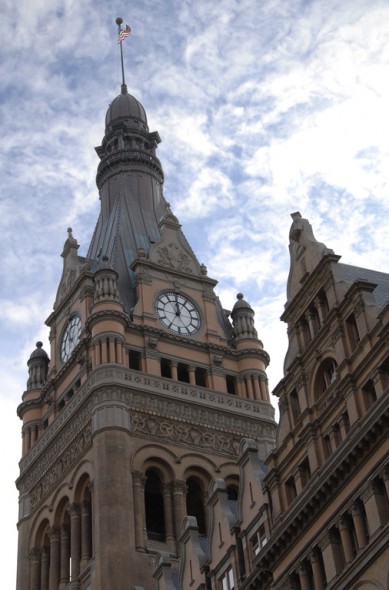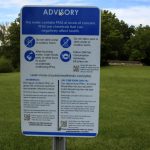Can City Solve Its Turnout Problem?
It badly trailed voter turnout in Madison and other areas in 2016.
In the age of Gov. Scott Walker, as Wisconsin has become one of the most politically polarized states in America, Democrats have no chance in statewide elections without a big turnout in Milwaukee and Madison. And the turnout has been far better in Madison and Dane County in recent years.
Consider the results of April’s spring election: Dane County saw 133,189 people vote, which was actually more than Milwaukee County’s 130,850 voters.
That’s right, Dane County with a population of 523,643, just 55 percent of Milwaukee County’s population of 957,735, actually had more voters.
Of course, that was a low-interest election, as least compared to a presidential year. But Milwaukee’s turnout in the 2016 presidential election was also a disappointment. Milwaukee County cast 60,000 less votes than in the prior presidential year of 2012.
That has often been blamed on a lack of enthusiasm for Democratic standard bearer Hillary Clinton, and on the fact she didn’t campaign in Wisconsin.
But how is it that had no impact on Dane County, where “turnout was nearly unchanged from 2012 to 2016, as Madison’s Cap Times reported in 2016. “In fact, Clinton received about 1,400 more votes this year than Obama did four years ago.”
Rep. Mark Pocan, whose Democratic congressional district includes Dane County, pointed to the get-out-the-vote effort in Madison: Democrats there did an “amazing” job, he told the Cap Times. And UW-Madison political science professor Barry Burden suggested Madison might have done better because of “its expanded early voting hours and locations.”
Madison had 14 place where early voting could be done, including all nine of Madison’s public libraries, and at Edgewood College and UW-Madison Union South. Milwaukee, which is more than twice as big as Madison, had just three places for early voting: in the Zeidler building next to City Hall, at Forest Home Library, 1432 W. Forest Home Ave., and Midtown Center, 5700 W. Capitol Dr. Unlike Madison, which had early voting at two campuses, Milwaukee had none.
Burden also pointed to efforts made by city and county clerks in Dane County to educate voters about their right to vote. “The two ways in which the cities dealt with early voting might explain why Madison held and Milwaukee dropped,” Burden told the Cap Times.
Madison had 63,853 absentee and early voters for the election, versus just 52,373 for Milwaukee, a city more than twice as large.
Neil Albrecht, executive director of the City of Milwaukee Election Commission, points to the fact it wasn’t until July of 2016 that U.S. District Judge James Peterson in Madison struck down a law passed by Republican legislators to restrict early voting hours and forbid early voting in more than one place in each municipality. (This created the greatest restriction on the state’s two biggest municipalities, Milwaukee and Madison).
Albrecht points to research showing the impact of early voting. “National data indicates you can boost turnout by two to three percent by having healthy early voting options.”
It results in some people voting who otherwise wouldn’t, and others switching to early voting, which relieves overcrowding at peak times for big city polling places. “Overcrowding causes some people not to vote,” he says.
Yet after noting this research, Albrecht then offers this seemingly contradictory opinion: “I feel 100 percent certain that in 2016 every person who wanted to vote early in Milwaukee had the opportunity to do so.”
Yet Albrecht and city officials have made plans to greatly expand early voting for this fall’s election. That includes expanding from three early voting sites to eight, including sites at UW-Milwaukee, MATC and four more neighborhood library branches (Mitchell, Zablocki, Center Street and Mill Road)
This will be part of “a substantial and unprecedented investment of over $502,000 to support early voting staffing and operations, including additional absentee ballot processors for central counting on Election Day,” Albrecht noted in a memo to the Milwaukee Common Council. Hours of operation for early voting polling places will increase to 2,178 total hours, “up from 725 in 2016 and 110 in 2014,” he noted.
Early voting on weekend and evening hours is particularly crucial for low-income voters, as Albrecht notes, because they have less flexibility in taking time off from work or child care, and may not own a car.
But Albrecht is convinced the biggest problem by far is caused by state laws that eliminated open registration and require photo ID, policies passed by Republican legislators. “Milwaukee’s population, with nearly one-third of the population at or below poverty, is significantly more impacted by those changes,” he says. “We’ve lost an equal or greater number of voters from less registration as from the photo ID requirement.”
The result is a lower turnout. “We were double digits behind the state in voter turnout in 2016,” Albrecht notes, which hadn’t been the case in past elections.
The latest change by the state which could affect turnout is its aggressive purging of voting rolls. “Some 44,000 voters were removed from city rolls after the state started using a new process in the Electronic Registration Information Center,” as the Journal Sentinel recently reported. Milwaukee Mayor Tom Barrett said that because incorrect data was provided by the state Department of Motor Vehicles and the U.S. Postal Service, “some voters who haven’t actually moved or changed addresses” were dropped from the rolls erroneously. “We are very concerned with the number of legitimate voters whose records have been deactivated,” Barrett told the newspaper.
That system “worked during the relatively low turnout April election,” Barrett tells Urban Milwaukee, “but would be cumbersome, slow, and prone to poll worker error in November. Obviously, my concern is that no voter’s right to vote be denied or impeded by these errors.”
Barrett has called on the elections commission to reactivate all voters dropped. Commission spokesman Reid Magney told the Journal Sentinel that “it is too late to move everyone (who was deactivated) back onto the poll list” for the April election, but says the commission will consider whether it can be done in time for the August and November elections at its next meeting on May 24.
Such are the challenges facing Milwaukee and other urban areas with higher populations of more transient low-income voters. These are voters who tend to support Democrats, and the less of them who vote, the better for Republicans. They have steadfastly erected every barrier they can to urban voters, and have appealed Peterson’s decision striking down early voting restrictions, and a federal court of appeals could rule on this issue before the fall election. Milwaukee and state Democrats may yet face even more challenges in assuring that all eligible voters are able to do so.
Correction: An early version of this story reported that the Election Commission had decided it cannot reactivate all voters erroneously dropped from the rolls by November; the commission has not yet made a decision.
If you think stories like this are important, become a member of Urban Milwaukee and help support real independent journalism. Plus you get some cool added benefits, all detailed here.
Murphy's Law
-
The Last Paycheck of Don Smiley
 Dec 17th, 2025 by Bruce Murphy
Dec 17th, 2025 by Bruce Murphy
-
Top Health Care Exec Paid $25.7 Million
 Dec 16th, 2025 by Bruce Murphy
Dec 16th, 2025 by Bruce Murphy
-
Milwaukee Mayor’s Power in Decline?
 Dec 10th, 2025 by Bruce Murphy
Dec 10th, 2025 by Bruce Murphy























Hillary’s effort (much like Feingold’s and Tammy’s currently) was to get out the white vote and presume the black vote. That is why she got a better turnout in Dane than Milwaukee. If you don’t do the outreach, don’t put black people in your commercials, and only talk about white shit (get it, that means Trump) it should perhaps not be surprising that the white turnout in Dane was higher than the black turnout in Milwaukee. That’s the race they run.
Put legalizing, taxing and regulating cannabis on the ballot and you’ll have the highest turnout in ages…no pun intended.
Dump Walker 2018
The physical act of voting in the city of Milwaukee is a hassle and could well be a reason for our low turn out. I moved a few blocks east from Wauwatosa and landed in Milwaukee. Voting in Wauwatosa was a breeze and enjoyable experience visiting with neighbors. My first voting experience in Milwaukee was a disaster. Aside from the long wait, the election clerk could not figure out the register in order to find someone’s name. I decided to become an election clerk and worked for three elections. Since I understood the alphabet I checked in voters; however, since my partner had long ago forgotten the alphabet I was unable to take a break. Seventeen hours without more than a quick pee break is more than my aged body can withstand. What is needed is a serious recruitment of qualified election workers.
The physical act of voting in Milwaukee is a hassle. I moved a few blocks east from Wauwatosa and landed in Milwaukee. Voting in Tosa was enjoyable, quick and professional. Voting in Milwaukee means long waits, and unqualified election officials. I decided to become an election official and worked for three elections. Since I was still acquainted with the alphabet I checked in voters. My partner had long forgotten every letter of the alphabet which meant I could take no breaks. A fifteen hour workday with no more than an occasional pee break was more than my aged body could accept. What is needed is recruit officials who can work at the polls, a body filling a seat in not a qualified worker.
Have candidates on the ballot that Milwaukee residents want to vote for.
Grandpakwh: we got more votes in the 60’s when you had to vote on election day or absentee with reason.
I voted in the February primary this year. When I went online to request an absentee ballot for the April general election. My name had been removed from the voters list. I went to the Election Office at Milwaukee’s City Hall and picked up my absentee ballot. Voted. Sure, it took more effort on my part, but I was going to vote.